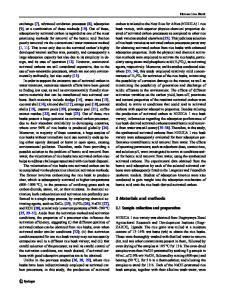Synthesis of Fullerols from an Aqueous Acid Method
- PDF / 349,278 Bytes
- 7 Pages / 420.48 x 639 pts Page_size
- 93 Downloads / 282 Views
SYNTHESIS OF FULLEROLS FROM AN AQUEOUS ACID METHOD LONG Y. CHIANG,* JOHN. W. SWIRCZEWSKI, CHANG S. HSU, S. K. CHOWDHURY, STEVE CAMERON, AND KATHY CREEGAN Corporate Research Laboratory, Exxon Research and Engineering Company, Annandale, New Jersey 08801 ABSTRACT An efficient aqueous acid chemistry for the preparation of fullerols, consisting of 14-15 hydroxyl moieties in an average structure, from C60 molecules is described. INTRODUCTION Recent macroscopic isolation of the unusual structural skeleton of fullerene carbon clusters1 has initiated intensive research activities aimed at the chemical modification of the double bonds of fullerene molecules to their tertiary substituted derivatives. These reactions include hydrogenation, 2 fluorination, 3 photochemical oxygenation, 4 methylation, 5 osmylation, 6 radical addition, 7 chlorination, 8 and diphenyl carbene addition. 9 The direct substitution of polar functionality on fullerene molecules, forming covalent carbon-hydroxy bondings, from a bulk reaction remains unknown. Here we report the first synthesis of fullerols 1 as polyhydroxylated fullerene derivatives. We found that the aqueous acid chemistry is an efficient method to introduce multiple hydroxyl groups onto fullerene molecules. 10 The chemistry produces fullerols in a high yield (more than double the quantity of starting materials was obtained). RESULTS AND DISCUSSION The study of synthetic condition was carried out using either pure C60 or a mixture of C60 (84%) and C70 (16%) in an aqueous acid medium containing sulfuric acid (40% by volume of conc. H 2 SO4 ) and nitric acid (40% by volume of conc. HNO 3 ) at different temperatures. Without nitric acid only a low yield of fullerol related products was obtained. The reaction was found to proceed most efficiently at temperatures between 85 and 115 oC using potassium nitrate as a precursor for nitric acid. The completion of reaction was easily determined when the reaction mixture became a clear yellowish brown solution, indicating a high solubility of polyhydroxylated fullerene products 1 in the acidic aqueous medium. After the reaction was completed, the acid solution was diluted with water and filtered through celite to remove any unreacted fullerene particles. Neutralization with NaOH to precipitate products followed. The full precipitation was achieved at pH greater than 9.0. The resulting fine amorphous brown solid product was found to be moderately soluble in water and very soluble in acidic water at pH < 5.0. In general, the thorough removal of water from partially hydrated products in vacuum at 50 oC affords a brittle brown solid with a slightly lower solubility in water. However, its solubility in acidic water remains unchanged.
Mat. Res. Soc. Symp. Proc. Vol. 270. @1992 Materials Research Society
242
Only a trace amount of starting C60 was recovered from this hydroxylation reaction. This is attributable to the partially hydroxy-substituted fullerene intermediate having a higher solubility in acidic water than unreacted fullerenes themselves. Thu
Data Loading...











